Relative size apparently makes no difference when birds are competing for nesting cavities. In this case the Northern Flickers are twelve times larger than the House Wren (130 g vs 11 g).
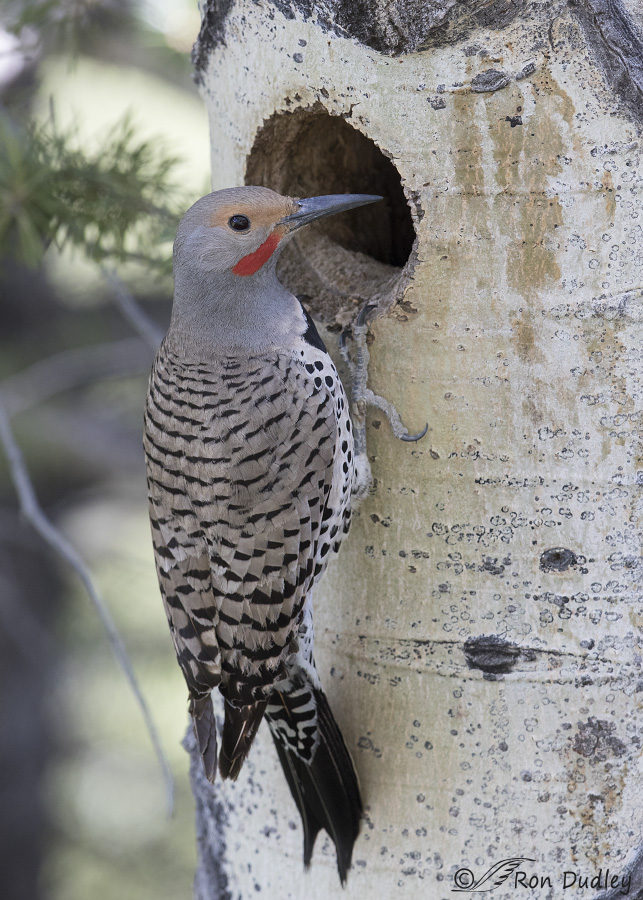
1/320, f/8, ISO 800, Canon 7D Mark II, Canon EF 500mm f/4L IS II USM, not baited, set up or called in
I photographed this flicker at its nest cavity two days ago in a remote area of Clark County, Idaho. The nest tree is within just a few feet of a narrow, steep and very rough and narrow dirt road used heavily by die-hard fishermen so the flickers have apparently become acclimated to nearby vehicles. I photographed the activity around the tree from my pickup on the road. The area is mostly deeply shaded so I was always struggling with light and depth of field and typically had very little shutter speed.
This is the male of the pair (red malar stripe) as he is about to enter the cavity.
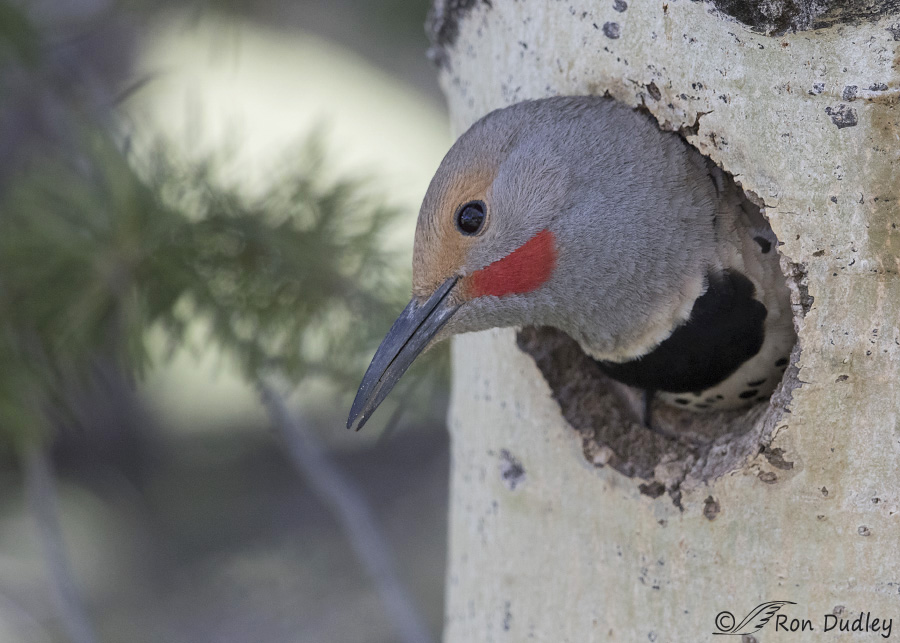 1/500, f/5.6, ISO 1600, Canon 7D Mark II, Canon EF 500mm f/4L IS II USM + 1.4 tc, not baited, set up or called in
1/500, f/5.6, ISO 1600, Canon 7D Mark II, Canon EF 500mm f/4L IS II USM + 1.4 tc, not baited, set up or called in
Her the male is checking out the neighborhood before he attends to some housekeeping. Notice that at these camera settings only his bill and face are sharp but in this situation I think the depth of field gives us an interesting and intimate photo.
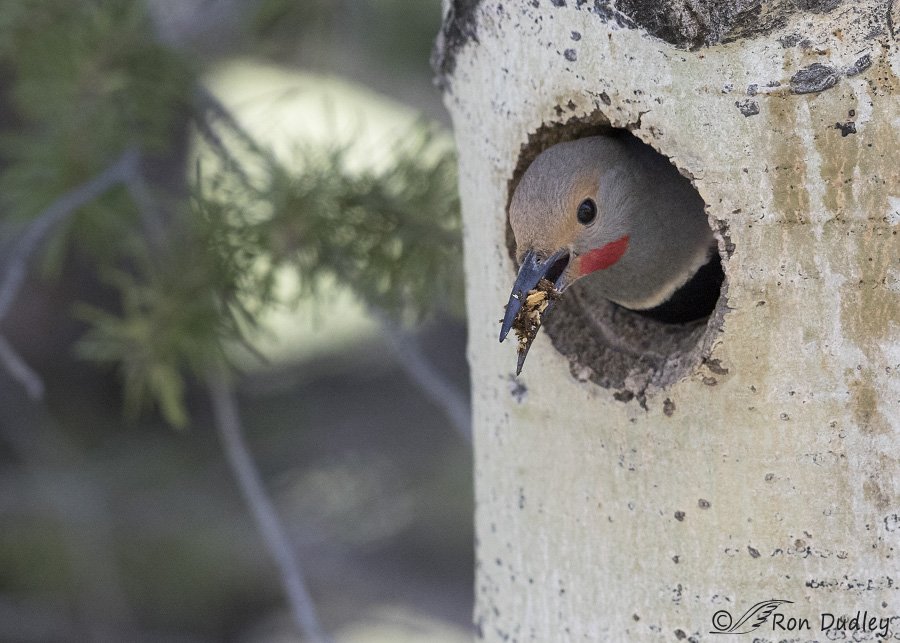
1/1600, f/5, ISO 2500, Canon 7D Mark II, Canon EF 500mm f/4L IS II USM, not baited, set up or called in
Occasionally I could hear him chipping away at the inside of the cavity to make it larger. Then he would bring a beak-full of wood chips to the entrance hole and…
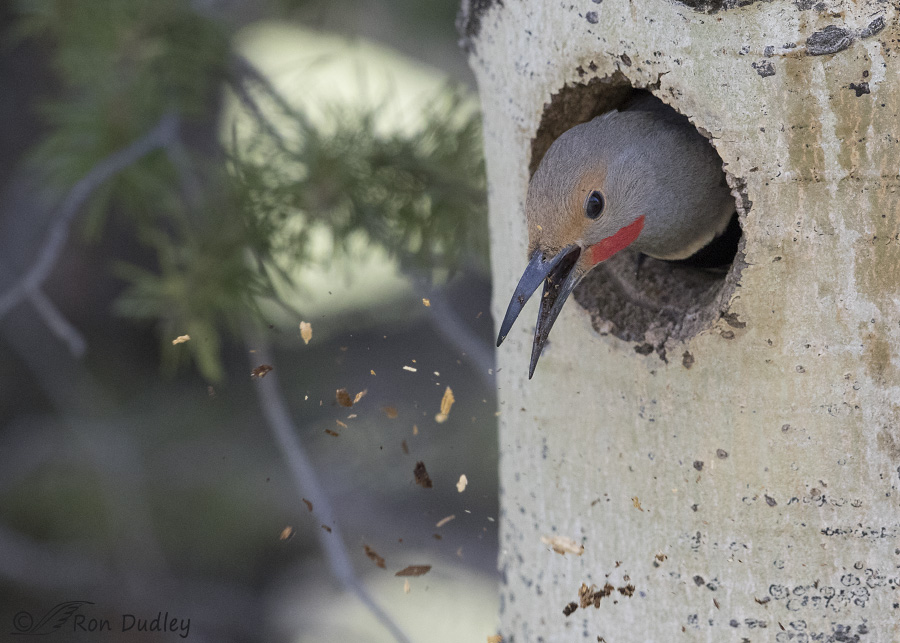
1/1600, f/5, ISO 2500, Canon 7D Mark II, Canon EF 500mm f/4L IS II USM, not baited, set up or called in
rapidly shake his head to send them flying. This behavior was very difficult to photograph in such low light. I had to go to ISO 2500 in order to gain enough shutter speed to mostly stop the action.
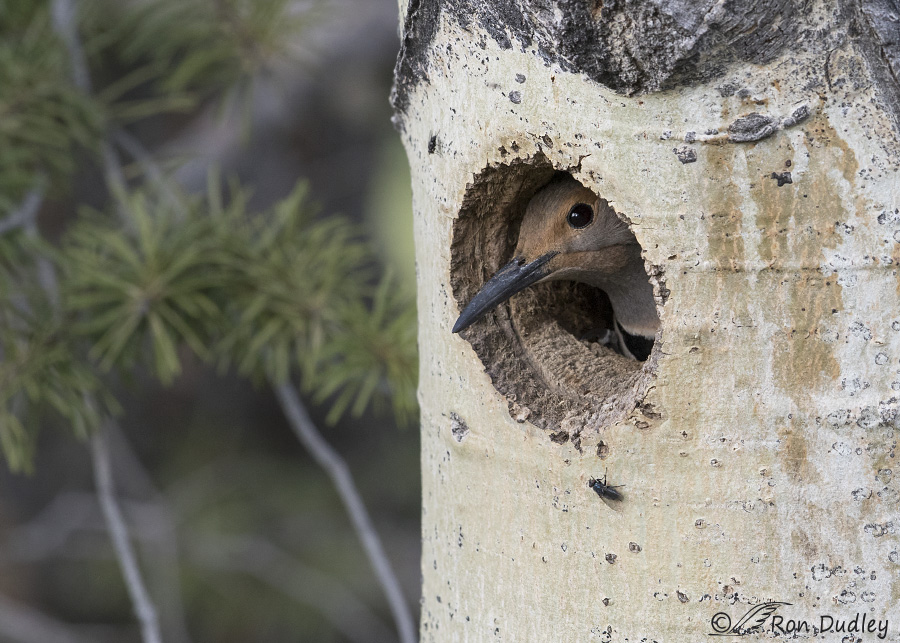
1/320, f/6.3, ISO 800, Canon 7D Mark II, Canon EF 500mm f/4L IS II USM, not baited, set up or called in
Later on the same day I found the female (no red malar stripe) peering out at me. This was the only time I saw her that I know of. Notice that she has two flies for company…
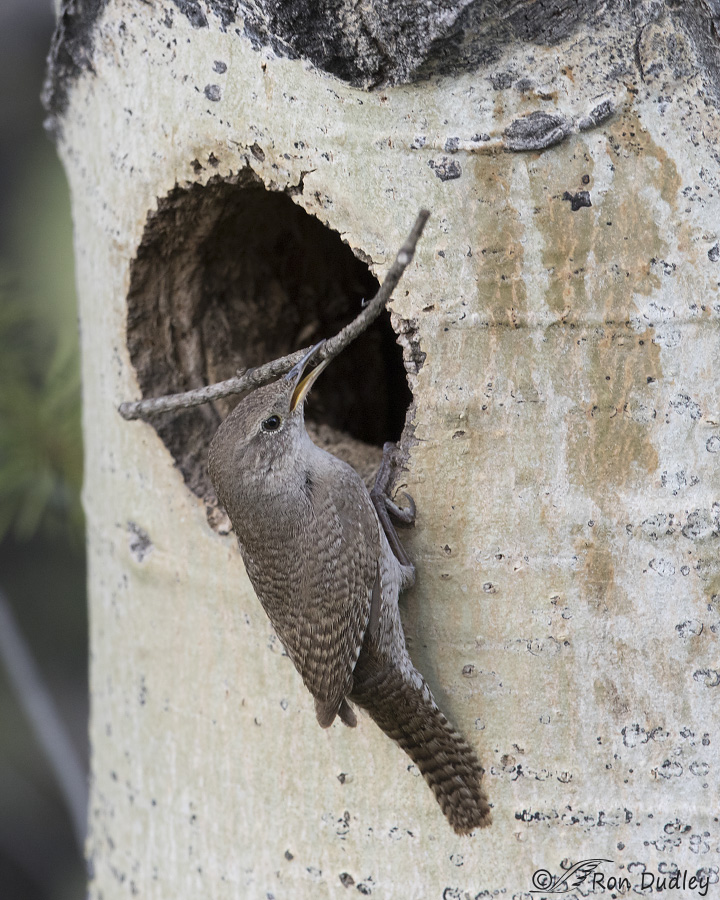
1/250, f/6.3, ISO 800, Canon 7D Mark II, Canon EF 500mm f/4L IS II USM, not baited, set up or called in
House Wrens are notoriously gutsy but the gall of this one surprised me. Just a few minutes after the female flicker left the cavity this diminutive wren brought nesting material to the same cavity.
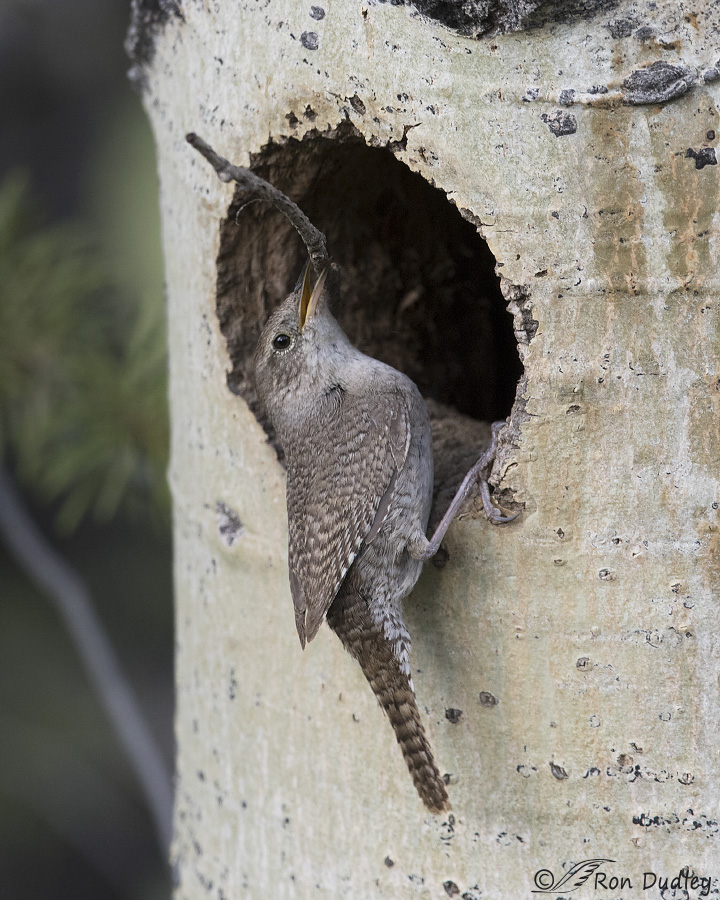
1/320, f/6.3, ISO 800, Canon 7D Mark II, Canon EF 500mm f/4L IS II USM, not baited, set up or called in
The wren struggled to get the twig into the nest hole…
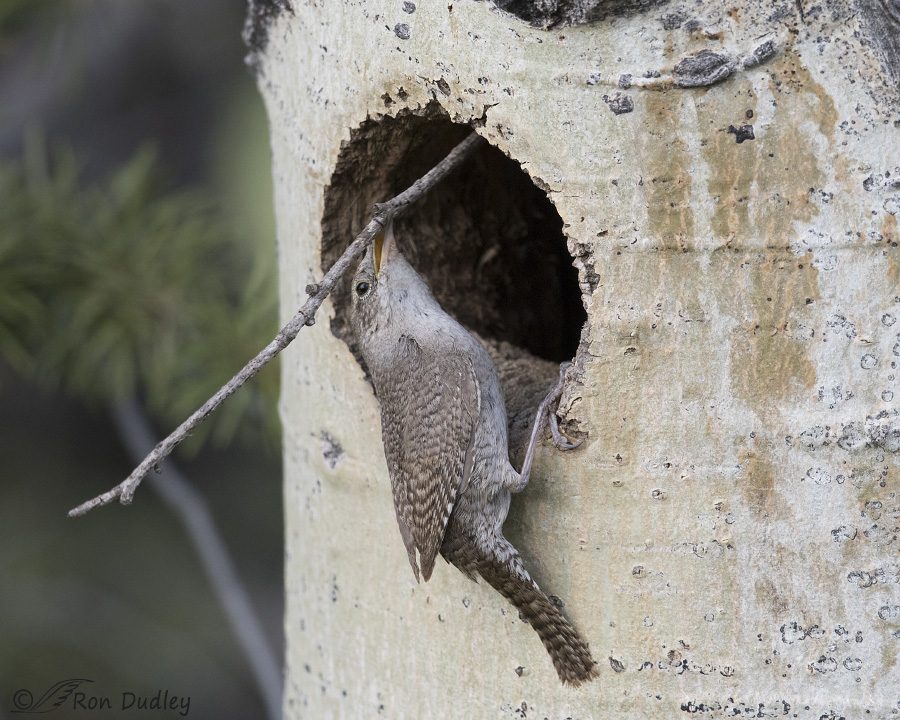
1/320, f/6.3, ISO 800, Canon 7D Mark II, Canon EF 500mm f/4L IS II USM, not baited, set up or called in
but eventually it succeeded. Both bird and twig disappeared into the cavity right after I took this image. It seems to me that the wren was taking a real chance. I can only imagine the mayhem that would likely result if one of the flickers came by and caught the wren inside the cavity.
I’ve now arrived home from my camping/photo trip to Montana and Idaho. We had a glorious time and the weather was excellent so we stayed a little longer than planned. It’s good to be home but we’re already talking about and preparing for our next trip to the area.
I appreciate the support from readers while I was away. Internet access is always problematic on these trips and this time it was worse than usual so I was mostly unable to respond to comments but many of you made them anyway. Thank you.
Ron


I’m impressed and amazed once again by how perfectly round birds can make those holes…and to think they do it without a compass!!!
Patty, I saw one cavity entrance this trip that was shaped like an ellipse. All others I’ve seen have been round.
Welcome home. Where the work of culling and editing will no doubt keep you busy for days.
I am always amazed at how many small birds punch well above their weight in feistiness. Their aggression frequently wins the day as well…
Culling and editing is right, EC. I have just over 6000 new images to cull and so far I’ve barely put a dent in them. I don’t have the enthusiasm for it right now. I really do not like culling – the only part of photography I don’t enjoy.
Welcome home Ron. I love all of these photos. I think my favorite is the second one. He looks so happy. I guess whoever lays the first egg will get the nest lol
Thank you, Debbie.
You’re right. He does look happy to me compared to the wary look of the female in the next photo. Did she know about the wren?
Make me want to bore a few more holes in old trees for them. I love the female flicker looking out of the nest.
April, as you well know, far too many people simply chop down old trees that are so often used for nesting cavities. Municipalities do it too and that’s a shame because they should (and probably do) know better.
Don’t get me started on that topic. The city has been through my area trimming and taking out whole old trees the last two weeks. I wish if they have too at least do it it fall not prime nest season.
In the case of the House Wren, carrying twigs to a hole is not always a sign of nest-building. Once they have selected their own nest hole, the male wren often attempts to fill any other nearby holes with twigs, making them less available for any competitors. In this case, it may not have been aware of the flickers, but just saw another hole to fill. Once the female begins laying eggs, the male has another habit that does not endear him to some people. He seeks out other nests in his territory, of any species, and pokes holes in those eggs. Western Bleubirds are often hard hit by wrens nesting nearby. The wren is not being “evil”; it’s just doing all it can to ensure that its young have the greatest chance of survival. Nature’s wonderful!
That’s fascinating behavior you’ve described, Dan. Thank you for providing it.
I saw (and photographed) what I believe to be the same wren a few minutes later with what looked like a beak-full of white plant “fuzz”, probably intended to line its own nest. The wren did not go into this cavity with it (that I noticed).
Probably cuts down on competition for food, especially re:with other species thatvrely on thecsame stuff. Interesting…hadn’t thought of that angle. Thanks, Dan…
I can’t help but say it again…i’ve NEVER been disappointed in the wonder of one of your blogs and NEVER not seen and learned something interesting and new…I find this amazing and am Soooo grateful!!!
And I’m so glad that you appreciate my posts, Patty. Thank you.
What Patty said! What a joy it is to learn something new every day!
This series has my curiosity up as to who won out for the nesting cavity. I wouldn’t be at all surprised if the Wren ended up with it. The gutsiness of small birds has always amazed me. They’ll stand up to any creature of any size that is interfering with what they want. Glad you had a good trip.
Susan, Hopefully I’ll be able to satisfy your curiosity (and my own) on my next trip to the area. If I do I’ll report back.
Enjoy your photos so much. Glad you had a good trip.
Thanks very much, Marge.
I forgot to mention the wren’s problem-solving skills in getting that twig into the nest! Wonder what the flickers did to get it out (assuming they won the nest territory battle over the wren).
Laura, it’s fascinating to watch them try so many strategies to get a large twig like this through the openings. I’ve watched the process many times over the last three years and my jaw literally drops during the process. Those little guys are THINKERS!
Yes, they and so many others are thinkers. While accipiters are excluded from this conversation ;-), most everybody contemplates things and works through their problems. But even accipiters do amazing math computations in their brains, instantaneously. I’m so often amazed at their sheer intelligence that while different from ours (most notably in its speed), is just as effective in THEIR world with THEIR priorities. If only we could step outside our humanity more frequently, we’d get that. But our steadfast belief that we’re the best and brightest ever blocks that realization for so many of us. We have SO much to learn.
Yes you do “see things others don’t,” simply because you’re out there and persistent/patient. I love that. I just love the series behavior and the beauty, and oh so many other things. And yes, you do have “magic in your eyes, hands and camera gear!” I love that about you, too! No that magic did NOT elude you–you’re just seeing your flaws instead, and while I get that and I know you’re going for sheer perfection, pretty damn spectacular is pretty damn spectacular.
And oh the wonder! Yes birds (and critters overall) have a lot to teach us if we’ll only listen.
Again, thank you so much, and those words just don’t even come close to my gratitude for this amazing wake-up call.
The next trip should always be on your mind and in your plans!
Thanks for the kind words, Laura.
Yup, the “next trip” is always on my mind this time of year. Don’t know where it will be to yet but all the possibilities are fun to think about.
Great images Ron. Glad you had a fun trip. The high ISO images on 7D2 look very good. Did you do any noise reduction in post processing?
Thanks, Ed. No, I didn’t use any NR on any of these images.
Thanks Ron. That is impressive. I need to start using my 7D2 more 😉
Ed, part of the reason for the relatively low noise level in these images is that most of them haven’t been cropped very much. As you know, the more you crop the more noise you get.
Wonderful series of photos Ron! Love the capture of the male shaking the wood chips out of his mouth. As I write this I hear ‘my’ male house wren singing near his latest ‘false’ nest and wondering which species he displaced this time!
They’re aggressive little rascals, aren’t they, Linda!
Glad you had a great time and these shots are awesome Ron!
Charlotte
Thank you on both counts, Charlotte.
VERY nice! 🙂 The wrens are gutsy. Presently I’m having a stand off with one determined to build a nest at the top of an outside roman shade on the house – I put the shade down and get a shower of twigs, pull it up and she starts again so I’m currently leaving it at half mast. 🙂
Ha, if the winner in your case is determined by persistence you’ll have to have a lot of it to come out on top, Judy. Good luck!
We had one take over a clothes pin basket by the door one summer! 🙂 Fine mess! 🙂
Hi Ron
Very nice series. You see things which others dont. Thanks for sharing.
“You see things which others don’t”
I try, Nikhil. Birds have a lot to teach us if we only pay close attention. Thank you.
You have magic in your eyes, hands and camera gear. You take the best shots!!!
Thanks, Zaphir, but that “magic” largely eluded me at this tree. It was very, very difficult shooting in these conditions. I was using two different cameras and lenses and swapping out the tc as I tried to match the conditions to the activity I was trying to photograph. I made many mistakes and I’ll be deleting many shots that had potential.
But damn, was it ever fun and I learned a lot, both about birds and about photo technique.
This field savvy birder, research scientist, and practicing witch appreciates your magic. You have personal magic that you are displaying but you might prefer a more technical term to describe your work than magician/alchemist.
The clarity of your shots has encouraged me to spend more time with each bird. I spent more on optics and am amazed at what I am now able to observe for the Wisconsin Breeding Bird Atlas 2. You teach me things I don’t know about species and encourage me to learn more about a subject I’ve been studying for 46 years in various places in the US.